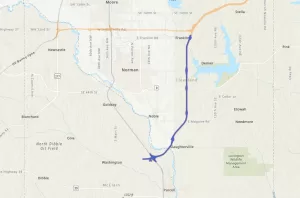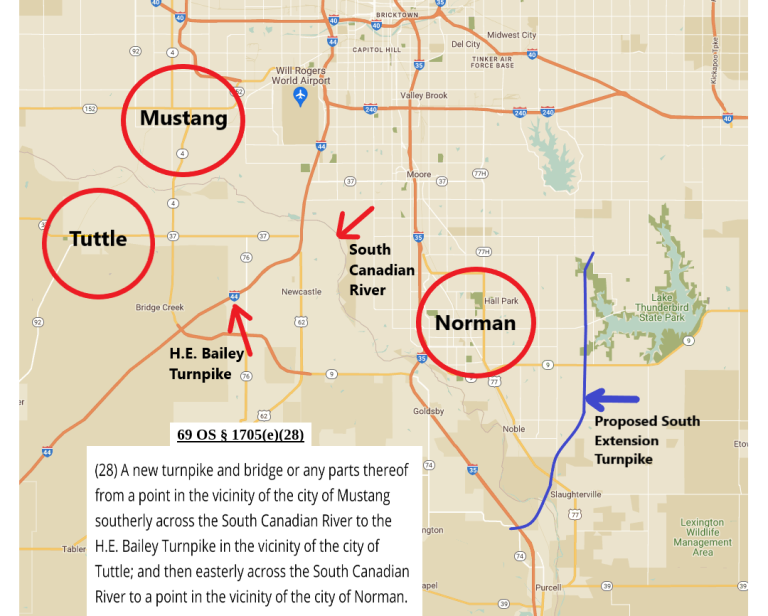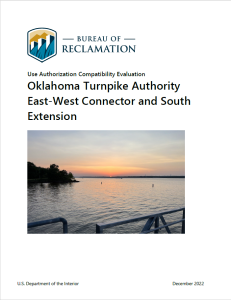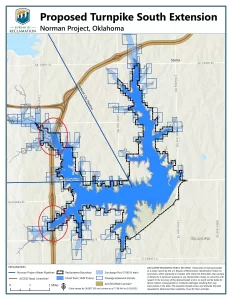August 2023 Update
On August 1, 2023, the Oklahoma Supreme Court voted 6-3 to validate the $5 billion ACCESS toll road expansion plan.
Despite the Supreme Court’s responsibility to interpret legislation (specifically the legislation that authorizes turnpike locations throughout the state), Judge Winchester’s ruling states a reluctance to “inject this Court into the OTA’s decision-making process regarding proposed turnpike routes.”
The August 1 Supreme Court ruling abdicates responsibility and gives free reign to OTA now and in the future. In the words of Justice Rowe:
“The OTA is apparently free to blatantly disregard the Legislature’s directives with respect to routes and funding.”
At this time, we do not know when or where the OTA will announce their new route locations to accommodate the Bureau of Reclamation denial. Many components are still in motion. As we learn more about the new route locations, and subsequent courses of action we can take on behalf of our community, we will keep you informed and primed to make the best decisions you can for you and your family.
January 2023 Update
January 18, 2023 the US Bureau of Reclamation formally denied the Oklahoma Turnpike Authorities application for the proposed South Extension turnpike route to cross federal land in two locations.
As a result of the USBR’s denial, OTA issued a statement to stakeholders saying
“The decision will require OTA modify the direction of the proposed alignment of the South Extension turnpike to avoid USBR fee title land.”
What the South Extension Is
The ACCESS Oklahoma South Extension turnpike is a proposed 19 mile stretch of new construction. It begins in far northeast Norman between Lake Stanley Draper and Lake Thunderbird then runs south to I-35 near Purcell. It includes interchanges at Franklin Rd, Alameda Drive, SH-9, Etowah Rd, US-77, and I-35.

View an aerial flyover of the prospective path of destruction on Pike Off OTA’s YouTube page: here
Why the South Extension is Unauthorized
Quite simply put, the Oklahoma Turnpike Authority can only build and operate turnpikes laid out in §69-1705 paragraph (e). This statute does not describe the south extension turnpike. Without enacting legislation it is not a legal route.
- Oklahoma statute §69-1705 lists 35 locations throughout the state at which the Legislature authorizes the OTA to construct and operate toll turnpikes.
- The Legislature never authorized the 19 mile ACCESS Oklahoma south extension turnpike.
- Without legislative authorization, the OTA cannot bond or build a turnpike.
What the Oklahoma Turnpike Authority Claims
The OTA claims the proposed ACCESS Oklahoma south extension was authorized in 1993 by 69 OS § 1705(e)(28). This section of the statute describes:
A new turnpike and bridge or any parts thereof from a point in the vicinity of the city of Mustang southerly across the South Canadian River to the H.E. Bailey Turnpike in the vicinity of the city of Tuttle; and then easterly across the South Canadian River to a point in the vicinity of the city of Norman.
It only takes looking at a map to see that 69 OS § 1705(e)(28) in no way describes the OTA’s proposed south extension.
What Oklahoma Geography Shows
Take a look for yourself. This map shows the proposed South Extension turnpike in blue. The map also notates other locations named in section (e)(28) of the statute with red circles or arrows. Does the blue line look like a route between Mustang and Tuttle and then easterly across the river to Norman to you?

In Pike Off OTA’s protest brief, attorney Robert Norman explains that section 28 does not authorize “a turnpike alignment that would start in the City [limits] of Purcell, run northeasterly through rural Cleveland County, continue northerly through virtually the entirety of East Norman, including Lake Thunderbird, and then finally meet with the proposed East-West Connector in far Northeast Norman at Indian Hills Road. Yet this is exactly the route the South Extension would take.”
The Legislature knows how to read a map. The people of Oklahoma know how to read a map. It is only the OTA that is directionally challenged.
What the Historical Evidence Shows
Historical evidence shows that in the 1990s the OTA understood geography. They knew the statute did not allow construction of a turnpike through east Norman to Purcell. Indeed in 1999 two bills were introduced in legislature (House Bill 1459 and Senate Bill 371) that described a turnpike extension to Purcell. These bills might have authorized the OTA to build the south extension. Both bills were rejected in the legislative process and never became law.
Oral arguments discussed this topic at the supreme court on November 28, 2022.
Supreme Court Justice: “Wasn’t there a bill in 1999 submitted to the legislature to create the south extension in basically the same direction that you seek today that failed in the legislature?”
The OTA attorney: “Yes your honor.“
Why would legislation be sought back then for the south extension if the statute already authorized it as the OTA now claims?
The OTA is Not Legally Authorized to Bond or Build the South Extension
From Pike Off OTA’s Protest Brief dated September 9, 2022:
“The OTA is trying to circumvent the people’s elected representatives and the rule of law with the proposed new turnpikes in ACCESS Oklahoma. A fundamental rule of the Courts is to vindicate the rule of law and curb government overreach, from wherever and however it may come. The OTA is not legally authorized to bond and build the East-West Connector, the Tri-City Connector, or the South Extension.“
@pikeoffota22 The Oklahoma Turnpike Authority wants to build an unauthorized turnpike and displace over 600 families. They tried this before and failed. Now they are trying again. #PikeOffOTA #GovernmentCorruption #EminentDomain #OklahomaSupremeCourt #OklahomaTurnpikeAuthority ♬ original sound - PIKE OFF OTA



